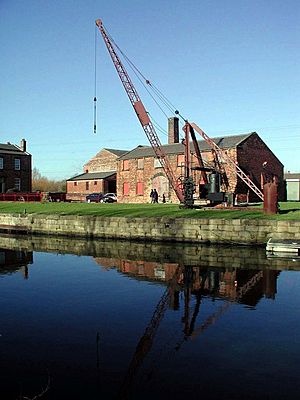Thwaite Mills facts for kids
Thwaite Mills is a cool historical place in Leeds, England. It's also known as Thwaite Watermill. This old factory sits right by the River Aire. It used the river's power to run its machines.
The mill was built a long time ago, between 1823 and 1825. It's one of the best examples of a working water-powered mill left in Britain. The mill building, the manager's house, and other buildings are all special Grade II listed buildings. This means they are important historical sites.
Thwaite Mills used to be a museum where you could visit. Leeds City Council ran it until April 1, 2024.
The Mill's Story
The very first mill here was built in 1641. It was a fulling mill, which means it cleaned and thickened woollen cloth. This was a big part of the local clothing industry back then.
In 1823, a company called the Aire and Calder Navigation took over the mill. They built two big new waterwheels. The site grew to include the mill, a manager's house, stables, a workshop, and a warehouse. There were also small houses for workers, but these were taken down in 1968.
What the Mill Made
Thwaite Mills was used for many different things over the years.
- One company crushed seeds to make oil for lamps and to keep machines running smoothly.
- They also crushed special woods that came from other countries. These woods were used to make dyes for coloring fabrics.
- Later, the Horn family ran the mill from 1872. They crushed flint and china stone for making pottery.
- They also ground chalk to make "whiting." Whiting was used in many products, from medicines to whitewash paint.
- After that, they crushed barytes for the paint industry.
- Until 1975, the mill made putty, which is used to seal windows.
The mill was on an island between the river and a canal. It tried to make everything it needed itself. There were workshops, fruit orchards, and fields for growing crops and grazing animals. The mill didn't even have electricity until 1986! It made its own power from the two waterwheels. A special engine bought in the 1930s also helped power some machines.
In January 1975, a wall in the river called a weir broke. This stopped the waterwheels from turning.
Saving Thwaite Mills
After the weir broke, a group of volunteers formed the Thwaite Mills Society in 1976. They wanted to save and fix this important historical place. They got help from the local council.
In 1978, six buildings at the mill were officially named Grade II listed buildings. This included the mill, the manager's house, and the machine shop.
The river weir was rebuilt, and the museum opened in 1990. Leeds City Council worked with Yorkshire Water to run it.
Visiting the Museum
At the museum, you could see the waterwheels working. There was also a collection of old machines used at the mill. The manager's house was set up to look like it did in the 1940s. You could walk through it and imagine life back then.
The museum also had a steam crane from 1946. There were even areas to see local wildlife. The museum often held special events for visitors.
The Canal & River Trust owns the site. Leeds City Council leased it and ran the museum through Leeds Museums & Galleries. However, in February 2024, the council decided to end its lease. The Canal & River Trust then announced they could not keep the museum open either. So, the museum closed its doors to the public on April 1, 2024.
See also
- Listed buildings in Leeds (City and Hunslet Ward - southern area)


